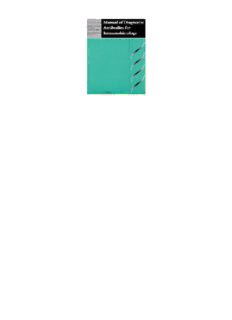
Manual of Diagnostic Antibodies for Immunohistology PDF
Preview Manual of Diagnostic Antibodies for Immunohistology
Page i Manual of Diagnostic Antibodies for Immunohistology Page ii 1999 Greenwich Medical Media Ltd 219 The Linen Hall 162-168 Regent Street London W1R 5TB ISBN 1 900151 316 First Published 1999 Distributed worldwide by Oxford University Press Page iii Manual of Diagnostic Antibodies for Immunohistology Anthony S-Y Leong MBBS, MD, FRCPA, FRCPath, FCAP, Hon. FHKCPath, FHKAM (Pathol) Professor of Anatomical and Cellular Pathology Department of Anatomical and Cellular Pathology The Prince of Wales Hospital The Chinese University of Hong Kong Shatin, Hong Kong Kum Cooper BSc (Hons), MBChB, DPhil (Oxon), FFPath, MRCPath Professor and Head School of Pathology and South African Institute for Medical Research University of Witwatersrand Johannesburg, South Africa F Joel W-M Leong MBBS Clinical Lecturer in Pathology Nuffield Department of Pathology John Radcliffe Hospital University of Oxford Oxford, United Kingdom Page iv To Wendy and Nimmie, for their love, strength and support Page v PREFACE The rapid acceptance and entrenchment of immunohistochemistry as an important and, in some cases, indispensable adjunct to morphological examination and diagnosis has imposed the necessity for anatomical pathology laboratories to be proficient in immuno-staining procedures. However, for immunohistochemistry stains to be meaningful, technical competence must be accompanied by a familiarity with the characteristics and specificities of the reagents employed. In particular, the medical technologist and pathologist must have knowledge of the sensitivity and specificity of the primary antibody employed, the nature of the epitope demonstrated by each antibody and its sensitivity to common fixatives. They should be equally conversant with protocols for tissue processing as well as the various methods of antigen/epitope retrieval which are appropriate for the demonstration of the specific protein sought in the tissue section or cell preparation. The versatility and contributions of immunohistochemistry to diagnostic pathology, particularly in the areas of tumor diagnosis, lineage identification, prognostication and therapy are largely dependent on the ever-increasing range of antisera and monoclonal antibodies which are commercially available. However, this latter feature is a two-edged sword. While the extensive spectrum of antibodies allows the identification of a wider and wider range of cellular antigens, the user must also be familiar with the properties and characteristics of each of these many antibodies. This book provides a comprehensive list of antisera and monoclonal antibodies that have useful diagnostic applications in tissue sections and cell preparations. Various clones, which are commercially available to detect the same antigen, are listed and the sensitivities and specificities of the antibodies are discussed. Importantly, our own experience with these reagents is provided, together with pertinent references. While as many available sources of antibodies are provided as possible, it is acknowledged that the listing cannot be exhaustive and only major sources are covered. A brief coverage of the diagnostic approach to the general categories of the poorly differentiated round cell and spindle cell tumors in various anatomical sites using panels of selected antibodies is provided in the form of tables. Staining protocols and antigen/epitope retrieval procedures, including those employing enzymes, microwaves and heat, are also given in detail. It is hoped that this compendium will provide a source of useful and practical information to both the diagnostic and research laboratory. ANTHONY S-Y LEONG MBBS, MD SHATIN, HONG KONG KUM COOPER MBBCH, DPHIL JOHANNESBURG, SOUTH AFRICA F JOEL W-M LEONG MBBS OXFORD, ENGLAND Page vi ACKNOWLEDGEMENTS We are grateful to the following for their invaluable help during the preparation of this book: Zenobia Haffajee, Johannesburg Trishe Y-M Leong, Adelaide Molly Long, Johannesburg Michael Osborn, Adelaide Raija T Sormunan, Hong Kong Page vii CONTENTS Preface v Acknowledgements vi Introduction x Section 1 Antibodies α-Smooth muscle actin (α-SMA) 3 α-1-Antichymotrypsin 5 α-1-Antitrypsin 7 α-Fetroprotein (AFP) 9 Amyloid 11 Androgen receptor 13 Antiapoptosis 15 Anti-p80 (ALK-NPM fusion protein) 19 Bcl-2 21 Ber-EP4 23 β-hCG (Human chorionic gonadotropin) 25 CA 125 27 N/97-Cadherin/E-cadherin 29 Calcitonin 33 Calretinin 35 Carcinoembryonic antigen (CEA) 37 Catenins, α, β, γ 39 Cathepsin D 41 CD 1 43 CD 2 45 CD 3 47 CD 4 49 CD 5 51 CD 7 53 CD 8 55 CD 9 57 CD 10 (CALLA) 59 CD 103 61 CD 11 63 CD 15 65 CD 19 67 CD 20 69 CD 21 71 CD 23 73 CD 24 75 CD 30 77 CD 31 81 CD 34 83 CD 35 85 CD 38 87 CD 40 89 CD 43 91 CD 44 93 CD 45 (Leukocyte common antigen) 95 CD 54 (ICAM-1) 99 CD 56 (Neural cell adhesion molecule) 101 CD 57 103 CD 68 107 CD 74 (LN2) 109 CD W75 (LN1) 111 CD 79a 113 CD99 (p30/32MIC2) 115 c-erbB-2 (Her-2, neu) 117 Chlamydia 119 Chromogranin 121 c-Mvyc 123 Collagen type IV 125 Cyclin D1 (bcl-1) 127 Cytokeratins 129 Cytokeratin 20 (CK 20) 133 Cytokeratin 7 (CK 7) 135 Cytokeratins-MNF 116 137 Cytokeratins-CAM 5.2 139 Cytokeratins-AE1/AE3 141 Cytokeratins-MAK-6 ® 143 Cytokeratins-34βE12 145 Cytomegalovirus (CMV) 147 Cytotoxic Molecules (TIA-1, Granzyme B, Perforin) 149
Description: